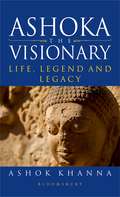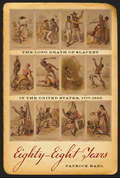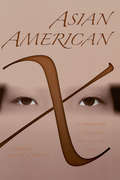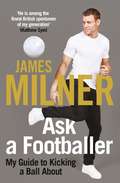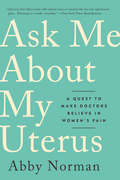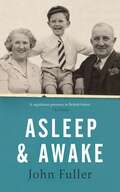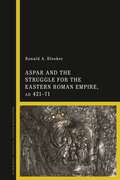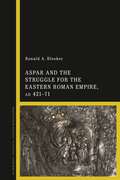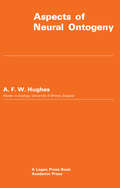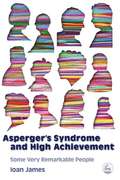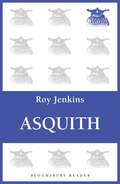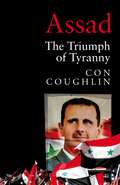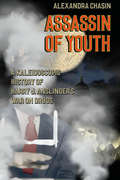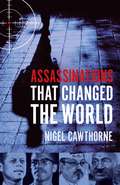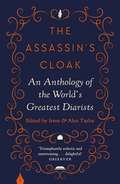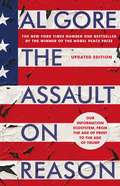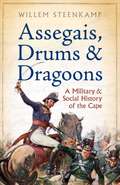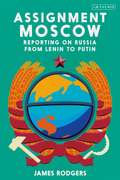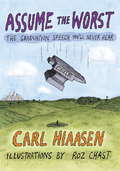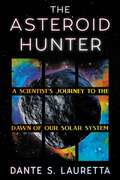- Table View
- List View
Ashoka, the Visionary: Life, Legend and Legacy
by Ashok KhannaUngainly in appearance, disliked by his father, the king, but nurtured by his mother, Ashoka worked to elicit his elders' approval. At the age of 18, his father sent him to quell a rebellion that his brother, the crown prince, had failed to do. His success propelled him to be appointed as viceroy of a province. There he met Devi, a beautiful, devout Buddhist. With the death of his father, supported by the chief minister, Ashoka was crowned the new king. Ashoka ruled the Indian subcontinent from 269 bce to 232 bce. After the Kalinga War, a turning point for Ashoka, his devotion to Buddha's teachings became unconditional, and he based his governance on its precepts of non-violence, tolerance and compassion. His support for Buddhism helped it grow from a small sect to a world religion. When it spread to Asia, his model of Dharmaraj was emulated as exemplary kingship by many Asian rulers through history. Prime Minister Nehru, in The Discovery of India, described Ashoka as 'a man who was greater than any king or emperor'. He worked to incorporate Ashoka's secular approach and considerate administration in India's Constitution. As a young democracy, India must adopt both Ashoka's and Nehru's vision of compassionate governance to mature as a nation.
Ashutosh Maharaj: Mahayogi ka Maharasya (Bloomsbury Revelations Ser.)
by Mr Sandeep DeoMahayogi Ashutosh Maharaj: The Master and the Mystic is about Shri Ashutosh Maharaj Ji, whose disciples have a firm conviction that he entered the state of samadhi on 28 January 2014. The medical world considers him to be clinically dead but his disciples strongly believe that Maharaj Ji will return to his body at a stipulated time; the reason being, before going into samadhi, he himself had revealed that he will be entering into this state. Not only this, even after assuming this state, he has revealed this fact to his disciples by manifesting in their inner, divine visions a number of times. That's why the disciples of Shri Ashutosh Maharaj Ji have preserved his body in a deep freezer for the last two years. It is an undeniable truth that Ashutosh Maharaj Ji is a secret-revealer, who unveils the divine light of the Supreme Lord within the inner being of his disciples by opening their Third Eye. He initiates his disciples into Brahm Gyan, which has been mentioned in the Vedas and the Upanishads. After all, who is not familiar with the Third Eye of Lord Shiva! Ashutosh Maharaj Ji clearly states that 'first behold God with your own eye (Third Eye), then repose your faith in any Guru.' Today, he has millions of followers all across the world. This is the first book written on Ashutosh Maharaj Ji. This book will reveal to the world as to who is this man who has once again brought into discussion the Vibhutipaad section of the Patanjali Yoga Sutras. The Vibhutipaadsection of the Patanjali Yoga Sutras talks about the different vibhutis (spiritual powers) acquired by a supreme yogi after he exercises his control on nature. One of these powers is the ability to renounce one's body for a long time. This book is an attempt to present the vivid persona of Shri Ashutosh Maharaj ji along with a lucid explanation of the same ancient knowledge, which is soon becoming extinct.
Asian American X: An Intersection of Twenty-First Century Asian American Voices
by Arar Han John Hsu"This diverse collection, like Asian America itself, adds up to something far more vibrant than the sum of its voices." -Eric Liu, author of The Accidental Asian "There's fury, dignity, and self-awareness in these essays. I found the voices to be energetic and the ideas exciting." -Diana Son, playwright (Stop Kiss) and co-producer (Law & Order: Criminal Intent) This refreshing and timely collection of coming-of-age essays, edited and written by young Asian Americans, powerfully captures the joys and struggles of their evolving identities as one of the fastest-growing groups in the nation and poignantly depicts the many oft-conflicting ties they feel to both American and Asian cultures. The essays also highlight the vast cultural diversity within the category of Asian American, yet ultimately reveal how these young people are truly American in their ideals and dreams. Asian American X is more than a book on identity; it is required reading both for young Asian Americans who seek to understand themselves and their social group, and for all who are interested in keeping abreast of the changing American social terrain.
Ask A Footballer
by James MilnerEver wondered what it's REALLY like to be a Premier League footballer?My name is James Milner and I'm not a Ribena-holic.Let me share insights into what it's like being a professional footballer, across my different experiences with Newcastle, Aston Villa, Manchester City and now Liverpool (not forgetting a six-match loan spell at Swindon). Plus my highs - and a few too many lows - playing for England. There isn't a current player who's been playing Premier League football as long as I have, and that gives me a pretty rare perspective into how the top-flight game has changed over the past seventeen years.In this book, I explain how a footballer's working week unfolds - what we eat and how we prepare for matches technically, tactically, mentally and physically - and talk you through the ups and downs of a matchday. I reveal my penalty-taking techniques, half-time team talks and the differences between playing against Lionel Messi, Wilfried Zaha and Jimmy Bullard. I've played for managers ranging from Terry Venables, Peter Reid and Sir Bobby Robson to Martin O'Neill, Fabio Capello and Jurgen Klopp. I tell you what it's like sharing a training ground and a dressing-room with team-mates such as Lee Bowyer, Mario Balotelli and Mo Salah. I also reveal the behind-the-scenes work that went into Liverpool's Champions League success - and the celebrations that followed.So this isn't an autobiography. The whole point of Ask A Footballer is that you, the fans, asked me questions and I have used my own experiences to answer them. I hope you like it, and don't find it too boring.
Ask Me About My Uterus: A Quest to Make Doctors Believe in Women's Pain
by Abby NormanFor any woman who has experienced illness, chronic pain, or endometriosis comes an inspiring memoir advocating for recognition of women's health issues In the fall of 2010, Abby Norman's strong dancer's body dropped forty pounds and gray hairs began to sprout from her temples. She was repeatedly hospitalized in excruciating pain, but the doctors insisted it was a urinary tract infection and sent her home with antibiotics. Unable to get out of bed, much less attend class, Norman dropped out of college and embarked on what would become a years-long journey to discover what was wrong with her. It wasn't until she took matters into her own hands -- securing a job in a hospital and educating herself over lunchtime reading in the medical library -- that she found an accurate diagnosis of endometriosis. In Ask Me About My Uterus, Norman describes what it was like to have her pain dismissed, to be told it was all in her head, only to be taken seriously when she was accompanied by a boyfriend who confirmed that her sexual performance was, indeed, compromised. Putting her own trials into a broader historical, sociocultural, and political context, Norman shows that women's bodies have long been the battleground of a never-ending war for power, control, medical knowledge, and truth. It's time to refute the belief that being a woman is a preexisting condition.
Asleep and Awake
by John FullerAn elegantly jubilant and personal new collection celebrating love, life and creativity from award-winning poet and Booker Prize-shortlisted novelist, John FullerIn this personal and characteristically brilliant new collection from John Fuller, an abundance of memories abound. From “those once endless years” of a childhood in wartime – tasting of Granny’s chicken soup, twizzers and cherry-go-rips – to the pattern of family and friendships, important milestones are brought to vivid life. In ‘Before We Met – and After’ a sequence of recollections cherish a wife on her eightieth birthday; ‘In Whose Head’ a piece by Schumann is revisited through advancing years; and in ‘Keeper of the Fire’ and ‘In Memory of John Bayley’ late poems of remembrance memorialise lost friends. These are poems of being and time, full of lyric feeling and Fuller’s distinctive wit and lightness of touch. Alive with the clang and sway of the “chosen colours of daily family life”, together they form a resonant gathering of poems that celebrate, with thoughtfulness and joy, “the feel and length of our lives”.
Aspar and the Struggle for the Eastern Roman Empire, AD 421–71
by Ronald A. BleekerThe first full-length biography in English of Aspar, the eastern Roman general and statesman, this book explores his central role in the history and politics of the fragmenting Roman Empire in the fifth century. It also considers what his life and career may suggest as to the differing fates of the eastern and western parts of the empire.Taking a chronological approach, Bleeker guides us through what is known of Aspar's life and his changing influence in the eastern Roman army and court. Born and raised in Constantinople, Aspar primarily viewed and presented himself as a Roman general, consul, and senator. Yet he also stood outside the Roman mainstream in two important ways–as a member of the empire's “barbarian” military leadership and as a devout Arian Christian. Early chapters treat his formative military experiences with the Persians, a Roman usurper in Italy, the Vandals in Africa, and the Huns of Attila, while later chapters focus on Aspar's political role in resolving the two imperial succession crises that struck the eastern Roman empire in the mid-fifth century and his extended struggle to control the succession to Leo I.Bleeker builds on earlier studies in three ways. First, previous work has largely concentrated on the role of “barbarian” generals in the western Roman empire, while much less attention has been paid to similar figures (such as Aspar) in the east. Secondly, while important recent work has explored the prevalence of “child-emperors” in the late-fourth and early-fifth centuries, this book suggests a further evolution of the imperial role in the mid-fifth century. Finally, while previous studies of this period have focused on Aspar's late career role in the succession struggles, a full study allows us to see how and why his relations with other key figures within and outside the eastern Roman government changed over the course of his lengthy career.
Aspar and the Struggle for the Eastern Roman Empire, AD 421–71
by Ronald A. BleekerThe first full-length biography in English of Aspar, the eastern Roman general and statesman, this book explores his central role in the history and politics of the fragmenting Roman Empire in the fifth century. It also considers what his life and career may suggest as to the differing fates of the eastern and western parts of the empire.Taking a chronological approach, Bleeker guides us through what is known of Aspar's life and his changing influence in the eastern Roman army and court. Born and raised in Constantinople, Aspar primarily viewed and presented himself as a Roman general, consul, and senator. Yet he also stood outside the Roman mainstream in two important ways–as a member of the empire's “barbarian” military leadership and as a devout Arian Christian. Early chapters treat his formative military experiences with the Persians, a Roman usurper in Italy, the Vandals in Africa, and the Huns of Attila, while later chapters focus on Aspar's political role in resolving the two imperial succession crises that struck the eastern Roman empire in the mid-fifth century and his extended struggle to control the succession to Leo I.Bleeker builds on earlier studies in three ways. First, previous work has largely concentrated on the role of “barbarian” generals in the western Roman empire, while much less attention has been paid to similar figures (such as Aspar) in the east. Secondly, while important recent work has explored the prevalence of “child-emperors” in the late-fourth and early-fifth centuries, this book suggests a further evolution of the imperial role in the mid-fifth century. Finally, while previous studies of this period have focused on Aspar's late career role in the succession struggles, a full study allows us to see how and why his relations with other key figures within and outside the eastern Roman government changed over the course of his lengthy career.
Aspects of Neural Ontogeny
by A. F. HughesAspects of Neural Ontogeny focuses on the interaction between the nervous system and peripheral organs during development, including history and development of neurons and the functions of nerves and muscles. The book first offers information on the development of neurons, including formation and growth of nerve fibers; growth cone and the extension of nerve fibers; history of the neuron theory; and path of nerve fibers. The manuscript then elaborates on the innervation of the tetrapod limb and the center and periphery. Discussions focus on the relationships between the ventral horn and muscles of the limb; experimental studies on limb plexus and limb nerves; and relationships between spinal nerves and limb muscles. The publication takes a look at the ontogeny of behavior, as well as pattern of motility, spontaneous movements, tetrapod limb, and experimental studies. The book is a dependable reference for readers interested in neural ontogeny.
Asperger's Syndrome and High Achievement: Some Very Remarkable People
by Ioan James'This book describes the lives and personalities of 20 remarkable people from the past, who may well have had Asperger's syndrome (AS). Famous in the fields of art, literature and science, among others, they illustrate vividly how highly intelligent people are able to surmount some of the problems that AS causes and achieve so much - more than might have been possible without it.' - Human Givens 'The aim of this book is to raise the self-esteem of individuals with AS. It certainly illustrates how much the world owes to people with AS. It would be relevant to anyone with an interest in AS.' - Good Autism Practice 'A highly readable text.' - Advances in Clinical Neuroscience and Rehabilitation 'Definitely worth a read.' - The National Association for Gifted Children 'James makes a convincing case for including each on the list. He also helps to explain what some dismiss as "artistic creativity" as actually a logical aspect of AS.' - Book News This fascinating collection identifies famous figures from the past whose behaviour suggests they may have had autism, a disorder that was not defined until the mid-20th century. James looks at the lives of 20 individuals - scientists, artists, politicians and philosophers - examining in detail their interests, successes, indifferences and shortcomings. Among the profiles are those of mathematician and philosopher Bertrand Russell, who wondered in his autobiography how he managed to hurt the people around him quite without meaning to; biologist Alfred Kinsey, who excelled in academia but was ill at ease in social situations; and the writer Patricia Highsmith, who had very definite likes (fountain pens and absence of noise) and dislikes (television and four-course meals). From Albert Einstein to Philip of Spain, these intriguing individuals all showed clear evidence of autistic traits. This book will be of interest to general readers and anyone with a personal or professional interest in autism.
Asperger's Syndrome and High Achievement: Some Very Remarkable People (PDF)
by Ioan James'This book describes the lives and personalities of 20 remarkable people from the past, who may well have had Asperger's syndrome (AS). Famous in the fields of art, literature and science, among others, they illustrate vividly how highly intelligent people are able to surmount some of the problems that AS causes and achieve so much - more than might have been possible without it.' - Human Givens 'The aim of this book is to raise the self-esteem of individuals with AS. It certainly illustrates how much the world owes to people with AS. It would be relevant to anyone with an interest in AS.' - Good Autism Practice 'A highly readable text.' - Advances in Clinical Neuroscience and Rehabilitation 'Definitely worth a read.' - The National Association for Gifted Children 'James makes a convincing case for including each on the list. He also helps to explain what some dismiss as "artistic creativity" as actually a logical aspect of AS.' - Book News This fascinating collection identifies famous figures from the past whose behaviour suggests they may have had autism, a disorder that was not defined until the mid-20th century. James looks at the lives of 20 individuals - scientists, artists, politicians and philosophers - examining in detail their interests, successes, indifferences and shortcomings. Among the profiles are those of mathematician and philosopher Bertrand Russell, who wondered in his autobiography how he managed to hurt the people around him quite without meaning to; biologist Alfred Kinsey, who excelled in academia but was ill at ease in social situations; and the writer Patricia Highsmith, who had very definite likes (fountain pens and absence of noise) and dislikes (television and four-course meals). From Albert Einstein to Philip of Spain, these intriguing individuals all showed clear evidence of autistic traits. This book will be of interest to general readers and anyone with a personal or professional interest in autism.
Asquith: From Gladstone Through To Young Churchill, Asquith, And Lloyd George - Is Blair Their Heir? (Senator Keith Davey Lectures)
by Roy JenkinsFirst published in 1964, Asquith was one of the most crucial and controversial of modern Prime Ministers. He was opposed with a bitterness and a violence that English politicians have not subsequently known, yet he enjoyed eight and a half years of unbroken power, and for at least the first six years of these he presided with an easy authority over the most talented government of this century. The issues which he confronted were momentous – Peers v. People, Ireland, and the Great War. Bringing to bear exceptional knowledge, judgement, insight and tolerance, he survived them all. His fall seemed therefore all the more shocking.
Assad: The Triumph of Tyranny
by Con Coughlin'Important, compelling, and detailed . . . a superb analysis of the West’s policy missteps and the tragic consequences of them.' - General David PetraeusIn Assad: The Triumph of Tyranny, Con Coughlin, veteran commentator on war in the Middle East and author of Saddam: The Secret Life, examines how a mild-mannered ophthalmic surgeon has transformed himself into the tyrannical ruler of a once flourishing country.Until the Arab Spring of 2011, the world’s view of Bashar al-Assad was largely benign. He and his wife, a former British banker, were viewed as philanthropic individuals doing their best to keep their country at peace. So much so that a profile of Mrs Assad in American Vogue was headlined ‘The Rose in the Desert’. Shortly after it appeared, Syria descended into the horrific civil war that has seen its cities reduced to rubble and thousands murdered and displaced, a civil war that is still raging over a decade later.In this vivid and authoritative account Con Coughlin draws together all the strands of Assad's remarkable story, revealing precisely how a young doctor ensured not only that he inherited the presidency from his father, but has held on to power by whatever means necessary, continuing to preside over one of the most brutal regimes of modern times.
Assassin of Youth: A Kaleidoscopic History of Harry J. Anslinger’s War on Drugs
by Alexandra ChasinCommissioner of the Federal Bureau of Narcotics from its establishment in 1930 until his retirement in 1962, Harry J. Anslinger is the United States’ little known first drug czar. Anslinger was a profligate propagandist with a flair for demonizing racial and immigrant groups and perhaps best known for his zealous pursuit of harsh drug penalties and his particular animus for marijuana users. But what made Anslinger who he was, and what cultural trends did he amplify and institutionalize? Having just passed the hundredth anniversary of the Harrison Act—which consolidated prohibitionist drug policy and led to the carceral state we have today—and even as public doubts about the drug war continue to grow, now is the perfect time to evaluate Anslinger’s social, cultural, and political legacy. In Assassin of Youth, Alexandra Chasin gives us a lyrical, digressive, funny, and ultimately riveting quasi-biography of Anslinger. Her treatment of the man, his times, and the world that arose around and through him is part cultural history, part kaleidoscopic meditation. Each of the short chapters is anchored in a historical document—the court decision in Webb v. US (1925), a 1935 map of East Harlem, FBN training materials from the 1950s, a personal letter from the Treasury Department in 1985—each of which opens onto Anslinger and his context. From the Pharmacopeia of 1820 to death of Sandra Bland in 2015, from the Pennsylvania Railroad to the last passenger pigeon, and with forays into gangster lives, CIA operatives, and popular detective stories, Chasin covers impressive ground. Assassin of Youth is as riotous and loose a history of drug laws as can be imagined—and yet it culminates in an arresting and precise revision of the emergence of drug prohibition. Today, even as marijuana is slowly being legalized, we still have not fully reckoned with the racist and xenophobic foundations of our cultural appetite for the severe punishment of drug offenders. In Assassin of Youth, Chasin shows us the deep, twisted roots of both our love and our hatred for drug prohibition.
Assassin of Youth: A Kaleidoscopic History of Harry J. Anslinger’s War on Drugs
by Alexandra ChasinCommissioner of the Federal Bureau of Narcotics from its establishment in 1930 until his retirement in 1962, Harry J. Anslinger is the United States’ little known first drug czar. Anslinger was a profligate propagandist with a flair for demonizing racial and immigrant groups and perhaps best known for his zealous pursuit of harsh drug penalties and his particular animus for marijuana users. But what made Anslinger who he was, and what cultural trends did he amplify and institutionalize? Having just passed the hundredth anniversary of the Harrison Act—which consolidated prohibitionist drug policy and led to the carceral state we have today—and even as public doubts about the drug war continue to grow, now is the perfect time to evaluate Anslinger’s social, cultural, and political legacy. In Assassin of Youth, Alexandra Chasin gives us a lyrical, digressive, funny, and ultimately riveting quasi-biography of Anslinger. Her treatment of the man, his times, and the world that arose around and through him is part cultural history, part kaleidoscopic meditation. Each of the short chapters is anchored in a historical document—the court decision in Webb v. US (1925), a 1935 map of East Harlem, FBN training materials from the 1950s, a personal letter from the Treasury Department in 1985—each of which opens onto Anslinger and his context. From the Pharmacopeia of 1820 to death of Sandra Bland in 2015, from the Pennsylvania Railroad to the last passenger pigeon, and with forays into gangster lives, CIA operatives, and popular detective stories, Chasin covers impressive ground. Assassin of Youth is as riotous and loose a history of drug laws as can be imagined—and yet it culminates in an arresting and precise revision of the emergence of drug prohibition. Today, even as marijuana is slowly being legalized, we still have not fully reckoned with the racist and xenophobic foundations of our cultural appetite for the severe punishment of drug offenders. In Assassin of Youth, Chasin shows us the deep, twisted roots of both our love and our hatred for drug prohibition.
Assassin of Youth: A Kaleidoscopic History of Harry J. Anslinger’s War on Drugs
by Alexandra ChasinCommissioner of the Federal Bureau of Narcotics from its establishment in 1930 until his retirement in 1962, Harry J. Anslinger is the United States’ little known first drug czar. Anslinger was a profligate propagandist with a flair for demonizing racial and immigrant groups and perhaps best known for his zealous pursuit of harsh drug penalties and his particular animus for marijuana users. But what made Anslinger who he was, and what cultural trends did he amplify and institutionalize? Having just passed the hundredth anniversary of the Harrison Act—which consolidated prohibitionist drug policy and led to the carceral state we have today—and even as public doubts about the drug war continue to grow, now is the perfect time to evaluate Anslinger’s social, cultural, and political legacy. In Assassin of Youth, Alexandra Chasin gives us a lyrical, digressive, funny, and ultimately riveting quasi-biography of Anslinger. Her treatment of the man, his times, and the world that arose around and through him is part cultural history, part kaleidoscopic meditation. Each of the short chapters is anchored in a historical document—the court decision in Webb v. US (1925), a 1935 map of East Harlem, FBN training materials from the 1950s, a personal letter from the Treasury Department in 1985—each of which opens onto Anslinger and his context. From the Pharmacopeia of 1820 to death of Sandra Bland in 2015, from the Pennsylvania Railroad to the last passenger pigeon, and with forays into gangster lives, CIA operatives, and popular detective stories, Chasin covers impressive ground. Assassin of Youth is as riotous and loose a history of drug laws as can be imagined—and yet it culminates in an arresting and precise revision of the emergence of drug prohibition. Today, even as marijuana is slowly being legalized, we still have not fully reckoned with the racist and xenophobic foundations of our cultural appetite for the severe punishment of drug offenders. In Assassin of Youth, Chasin shows us the deep, twisted roots of both our love and our hatred for drug prohibition.
Assassin of Youth: A Kaleidoscopic History of Harry J. Anslinger’s War on Drugs
by Alexandra ChasinCommissioner of the Federal Bureau of Narcotics from its establishment in 1930 until his retirement in 1962, Harry J. Anslinger is the United States’ little known first drug czar. Anslinger was a profligate propagandist with a flair for demonizing racial and immigrant groups and perhaps best known for his zealous pursuit of harsh drug penalties and his particular animus for marijuana users. But what made Anslinger who he was, and what cultural trends did he amplify and institutionalize? Having just passed the hundredth anniversary of the Harrison Act—which consolidated prohibitionist drug policy and led to the carceral state we have today—and even as public doubts about the drug war continue to grow, now is the perfect time to evaluate Anslinger’s social, cultural, and political legacy. In Assassin of Youth, Alexandra Chasin gives us a lyrical, digressive, funny, and ultimately riveting quasi-biography of Anslinger. Her treatment of the man, his times, and the world that arose around and through him is part cultural history, part kaleidoscopic meditation. Each of the short chapters is anchored in a historical document—the court decision in Webb v. US (1925), a 1935 map of East Harlem, FBN training materials from the 1950s, a personal letter from the Treasury Department in 1985—each of which opens onto Anslinger and his context. From the Pharmacopeia of 1820 to death of Sandra Bland in 2015, from the Pennsylvania Railroad to the last passenger pigeon, and with forays into gangster lives, CIA operatives, and popular detective stories, Chasin covers impressive ground. Assassin of Youth is as riotous and loose a history of drug laws as can be imagined—and yet it culminates in an arresting and precise revision of the emergence of drug prohibition. Today, even as marijuana is slowly being legalized, we still have not fully reckoned with the racist and xenophobic foundations of our cultural appetite for the severe punishment of drug offenders. In Assassin of Youth, Chasin shows us the deep, twisted roots of both our love and our hatred for drug prohibition.
Assassinations That Changed The World
by Nigel CawthorneWe live in an age of asymmetric warfare. Huge armies no longer face each other on the battlefield. Instead heads of major powers and lone assassins (or martyrs) target each other to pursue their agendas. President Donald Trump felt it necessary to use drones to blow away the Iranian Revolutionary Guard's Qasem Soleimani-a mastermind of terrorism in the Middle East who threatened the lives of US troops-and President Barack Obama felt fully justified in sending in US Navy SEALs to take out Osama bin Laden in Pakistan. This is the nature of modern warfare. And it is only going to get worse.When nineteen-year-old Gavrilo Princip assassinated Archduke Franz Ferdinand, heir to the Austrian throne, in 1914, he triggered the First World War. Few assassinations have had such devastating consequences, but political assassinations have always changed the world – often in ways that the assassins and their cohorts could not have predicted. The murder of John F. Kennedy left Lyndon B. Johnson free to escalate the war in Vietnam. However, the assassination of Martin Luther King, Jr. while not derailing the demands for African American civil rights in the US, did lead many to abandoning his commitment to nonviolence and adopting more radical means. In a world globalized by social media, more lone-wolf assassins seek their fifteen minutes of fame by taking out a famous figure, while leaders of world powers have everything to gain by decapitating terrorist organizations, employing the latest surveillance technology to obliterate their leaders. There are forty-eight assassinations that changed the world in this book. Rest assured that in the coming years we will see many more.
The Assassin's Cloak: An Anthology of the World's Greatest Diarists
by Irene and Alan Taylor'A diary is an assassin's cloak which we wear when we stab a comrade in the back with a pen', wrote William Soutar in 1934. But a diary is also a place for recording everyday thoughts and special occasions, private fears and hopeful dreams. The Assassin's Cloak gathers together some of the most entertaining and inspiring entries for each day of the year, as writers ranging from Queen Victoria to Andy Warhol, Samuel Pepys to Adrian Mole, pen their musings on the historic and the mundane. Spanning centuries and international in scope, this peerless anthology pays tribute to a genre that is at once the most intimate and public of all literary forms. This new updated edition is published to mark the twentieth anniversary of the book's original publication.
The Assault on Reason: Our Information Ecosystem, from the Age of Print to the Era of Trump (Thorndike Basic Ser.)
by Al GoreNow with a New Preface and Conclusion: 'Post-Truth: On Donald Trump and the 2016 Election' The United States of America is in the midst of a deepening crisis for their democracy. After the strangest election cycle in modern American history it is important that the grave threats to the American way of life that were glaringly revealed in this campaign are addressed. In The Assault on Reason, Nobel Peace Prize winner and former Vice President Al Gore examines how faith in the power of reason – the idea that citizens can govern themselves through rational debate – is in peril. Democracy depends on a well-informed citizenry and a two-way conversation about ideas, but the public sphere has been degraded by fake news and the politics of fear, partisanship and blind faith. Now updated to investigate the rise of Trump and post-truth politics, The Assault on Reason is a farsighted and powerful manifesto for clear thinking, crucial if the vitality of democracy is to be rebuilt and good decisions made once more.
Assegais, Drums & Dragoons: A Military And Social History Of The Cape
by Willem SteenkampWhat motivated a small multiracial force of Cape-born soldiers - whites, coloureds and Malays - to put up such stiff resistance at the Battle of Blaauwberg in 1806, in spite of odds so overwhelming that even some long-serving professional soldiers broke rank and ran? This was the intriguing question that launched author Willem Steenkamp's research. It was an investigation which eventually took him back to 150 years before Jan van Riebeeck landed at the Cape in 1652, and involved examining the social as well as the military history of the Cape. What Steenkamp discovered differs from what most South Africans think about that period, and he corrects a number of serious misconceptions not only about the soldiers of 1510-1806 but about the social and political development of the Cape. For students of the Napoleonic Wars, the book provides new information about a forgotten aspect of that conflict; for the ordinary reader here is a story no-one has ever told before in its entirety. Assegais, Drums and Dragoons: A Military and Social History of the Cape is a well-researched and fascinating account that now illuminates a previously lightless corner of South African military history Descended from a 1690s-era solider, Willem Steenkamp is a writer, journalist and specialist tour guide who has also been a solider, a security advisor and a director of military tattoos and other spectacles, among several other things. Since childhood he has been absorbing the Cape's history from family stories (one of his ancestors was a hero of the Battle of Blaauwberg) and voluminous reading. And yes, he actually has fired flintlock muskets and muzzle-loading cannon. Willem lives in Cape Town.
Assignment Moscow: Reporting on Russia from Lenin to Putin
by James RodgersThe story of western correspondents in Russia is the story of Russia's attitude to the west. Russia has at different times been alternately open to western ideas and contacts, cautious and distant or, for much of the twentieth century, all but closed off. From the revolutionary period of the First World War onwards, correspondents in Russia have striven to tell the story of a country known to few outsiders. Their stories have not always been well received by political elites, audiences, and even editors in their own countries-but their accounts have been a huge influence on how the West understands Russia. Not always perfect, at times downright misleading, they have, overall, been immensely valuable. In Assignment Moscow, former foreign correspondent James Rodgers analyses the news coverage of Russia throughout history, from the coverage of the siege of the Winter Palace and a plot to kill Stalin, to the Chernobyl explosion and the Salisbury poison scandal.
Assignment Moscow: Reporting on Russia from Lenin to Putin
by James RodgersThe story of western correspondents in Russia is the story of Russia's attitude to the west. Russia has at different times been alternately open to western ideas and contacts, cautious and distant or, for much of the twentieth century, all but closed off. From the revolutionary period of the First World War onwards, correspondents in Russia have striven to tell the story of a country known to few outsiders. Their stories have not always been well received by political elites, audiences, and even editors in their own countries-but their accounts have been a huge influence on how the West understands Russia. Not always perfect, at times downright misleading, they have, overall, been immensely valuable. In Assignment Moscow, former foreign correspondent James Rodgers analyses the news coverage of Russia throughout history, from the coverage of the siege of the Winter Palace and a plot to kill Stalin, to the Chernobyl explosion and the Salisbury poison scandal.
Assume the Worst: The Graduation Speech You'll Never Hear
by Carl HiaasenThis is the ultimate hilarious, cynical, but absolutely realistic view of a college graduate's future. And what he or she can or can't do about it."This commencement address will never be given, because graduation speakers are supposed to offer encouragement and inspiration. That's not what you need. You need a warning."So begins Carl Hiaasen's attempt to prepare young men and women for their future. And who better to warn them about their precarious paths forward than Carl Hiaasen? The answer, after reading Assume the Worst, is: nobody.Illustrated by bestselling author/illustrator and National Book Award winner Roz Chast, this book is bound to be a classic, sold year after year come graduation time. Although it's also a good gift for anyone starting a job, getting married, or recently released from prison. Because it is not just funny. It is, in its own Hiaasen way, extremely wise and even hopeful. Well, it might not be full of hope, but there are certainly enough slivers of the stuff in there to more than keep us all going.
The Asteroid Hunter: A Scientist's Journey to the Dawn of our Solar System
by Dante LaurettaA "captivating, behind-the-scenes account" of NASA&’s historic OSIRIS-REx mission to return an asteroid sample and unlock the mystery of formation on life on earth braided with the remarkable life story of the mission&’s leader, Dr. Dante Lauretta (Sara Seager). On September 11, 1999, humanity made a monumental discovery in the vastness of space. Scientists uncovered an asteroid of immense scientific importance—a colossal celestial entity. As massive as an aircraft carrier and towering as high as the iconic Empire State Building, this cosmic titan was later named Bennu. Remarkable for much more than its size, Bennu belonged to a rare breed of asteroids capable of revealing the essence of life itself. But just as Bennu became a beacon of promise, researchers identified a grave danger. Hurtling through space, it threatens to collide with our planet on September 24, 2182. Leading the expedition was Dr. Dante Lauretta, the Principal Investigator of NASA's audacious OSIRIS-REx Asteroid Sample Return Mission. Tasked with unraveling Bennu's mysteries, his team embarked on a daring quest to retrieve a precious sample from the asteroid's surface — one that held the potential to not only unlock the secrets of life's origins but also to avert an unprecedented catastrophe. A tale of destiny and danger, The Asteroid Hunter chronicles the high-stakes mission firsthand, narrated by Dr. Lauretta. It offers readers an intimate glimpse into the riveting exploits of the mission and Dr. Lauretta's wild, winding personal journey to Bennu and back. Peeling back the curtain on the wonders of the cosmos, this enthralling account promises a rare glimpse into the tightly woven fabric of scientific exploration, where technical precision converges with humanity&’s profound curiosity and indominable spirit.
